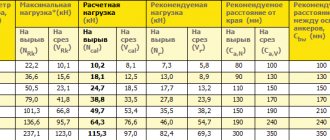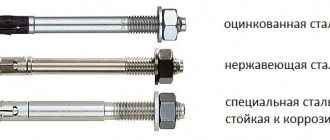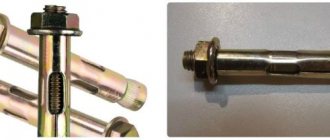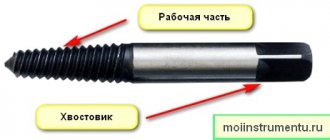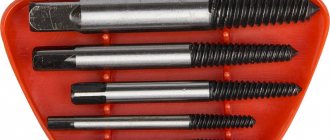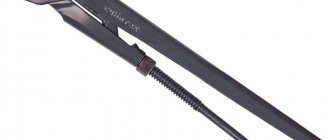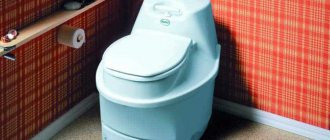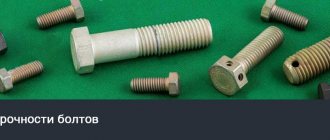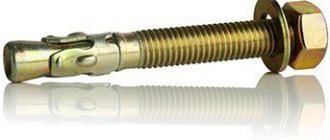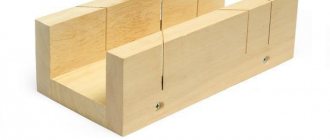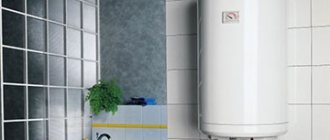X
Anchors for concrete are special fasteners. With their help, you can hang a shelf or cabinet on the wall and not be afraid that it will fall. Anchors are used where self-tapping screws or nails cannot be used. In order to choose the appropriate type of anchor, you first need to understand the variety of metal fasteners for concrete. This is what we will do in our article. The word “anchor” is translated as “anchor” and has a similar principle of operation. With the help of special protrusions, the anchor bolt clings so tightly to the walls of the hole that it can no longer be pulled out.
Mechanical anchors
The most common and inexpensive fastener for concrete, as well as other hard materials such as brick or natural stone, are mechanical anchors. They come in several types and differ from each other in the installation method and the type of adhesion to the base material. They are made from durable steel grades, stainless or treated with anti-corrosion compounds. Sometimes such products are called metal dowels.
For adhesion to hard and heterogeneous material, anchors are equipped with special threads, sleeves, collets, bushings and other additional elements that increase friction and prevent shifting, tearing out or bending of the fasteners.
How to secure an anchor bolt in concrete depends on the type of fastener and construction technology. Most of these hardware can be installed both in solid concrete and in liquid mortar before it begins to harden. Installation in mortar is usually used when pouring foundations and monolithic armored belts for subsequent fastening of walls and roofing structures to them.
Anchor bolts in foundation formwork Source gregvan.com
The anchor is fixed in the formwork by welding and tied to the reinforcement with wire. For reliability, its lower end is bent or a metal pad is welded onto it. The poured concrete tightly envelops the lower part of the hardware, there are no voids left between them, so after final hardening the adhesion is very reliable and immovable.
Advice! Before pouring the solution, wrap the anchors with film or tape to avoid clogging the threads.
Masking tape will protect the bolts from the mortar Source towerbuild.com
But the need to install fasteners in ready-made concrete structures arises much more often. To mount a flight of stairs, secure a canopy, decorate walls with façade panels, hang a boiler on a wall or a chandelier from the ceiling, different anchors are required. You need to be able to select them based on their design, base material and loads. Installation of any mechanical anchor in a concrete base requires pre-drilling of holes.
Note! The depth of the installation hole is made several millimeters greater than the length of the working part of the fastener, since concrete dust and debris remain in the well, which cannot be completely removed.
Spacers
The design of expansion anchors consists of a threaded rod and a short expansion sleeve or a long sleeve with slots and projections.
Expansion anchor bolt with sleeve Source stroyportal.ru
- One end of the rod is made in the form of a cone with a flared base, the other is threaded.
- The sleeve is put on the smooth part of the pin and rests against the cone.
- The movement of the sleeve towards the thread stops the restrictive ring.
- After installing the fastener into the hole, a nut is screwed onto the thread, and the pin wedges the sleeve, the petals of which begin to slide along the cone, opening and increasing the fit to the walls of the well and increasing the friction forces, thanks to which the anchor is firmly held in the concrete.
- The protrusions on the sleeve prevent it from turning when tightened.
This fastener is only suitable for hard concrete, since wedging creates quite large local bursting loads on the walls of the hole, which can be destructive for cellular concrete and other low-density materials. It is very popular, since it is quick to screw an anchor bolt into concrete, and the quality of fastening is high.
Another type of expansion anchor has a sleeve, the length of which is equal to the distance between the nut screwed onto the stud and the conical extension. The anchor bolt with a hex head instead of a cone is equipped with a long spacer nut with one ground edge.
The expansion anchor pin can end with a hook or ring for fastening suspended structures Source rubilnik.ru
The reliability of fastening with expansion anchors and their high load-bearing capacity is also ensured by the fact that they fit very tightly into the hole, since their diameters are the same. And the most reliable are double-expansion anchors. Instead of one long sleeve, two are put on the rod, which more evenly distributes internal stresses and provides support at the end and middle of the anchorage.
Double-expansion anchors can be used in medium-density concrete Source bricoman.pl
See also: Catalog of companies that specialize in the design and reconstruction of houses of any complexity
The installation process is as follows:
- in concrete, a hole of the same diameter as the rod is drilled with a hammer drill or impact drill;
- Remove debris generated during drilling from the hole using a vacuum cleaner, a special syringe or a rubber bulb;
- the anchor is inserted into the prepared well;
- since it fits in quite tightly, you can lightly tap it with a hammer through a wooden pad;
- A washer is placed on the protruding end, then the nut is screwed on with a wrench.
Sequence of installation of expansion anchor Source vsecuplu.ru
Wedge
Another name for a wedge anchor is a ceiling or wedge anchor. It is designed for attaching suspended structures to solid foundations without cracks. These are light suspended ceilings, metal slats and profiles, ventilation grilles and air ducts, cable systems.
Note! Wedge structures are non-removable, so marking must be done with high precision.
The main difference from spacer-type products is the absence of threads, since an anchor bolt can only be installed into concrete using a hammer. It consists of a rod with a locking head and a wedge-shaped spacer.
Wedge anchor for concrete Source allegroimg.com
- A rod 40-60 mm long has a longitudinal cut, which disappears towards the end, causing the leg of the rod to expand.
- A head in the form of a round plate with a hole for a wedge is welded onto the upper part of the rod.
- The cross section of the upper part of the spacer wedge is similar to the shape of the hole in the head. Under the head, the wedge is equipped with locking protrusions, and its end is tapered.
The anchor is inserted into the hole through the attached product and fixed with hammer blows on the protruding end of the wedge. Moving deeper, he slides along the beveled side of the rod and stands upright. When the wedge is completely driven into the cavity, only the flat head of the anchor remains on the surface.
Fastening perforated tape with a wedge anchor Source e-innovation.biz
Frame
A frame anchor bolt is a type of spacer product designed for fastening door and window frames into openings made of brick and concrete. A distinctive feature is a bushing cut along its entire length, in the upper part of which there are protrusions that prevent it from turning during installation. Instead of a nut or a hex head, there is a countersunk flat head with a Phillips slot for a screwdriver on the front side.
Frame anchor for securing door frames Source dropship-b2b.com.ua
The method for attaching anchor bolts to concrete is similar.
- Holes for frame bolts are drilled in the walls of the opening.
- Through holes of the same diameter are made in a wooden box.
- The total depth of the hole and the thickness of the box should be slightly greater than the length of the anchor.
- The box is placed in place until the holes in it and in the opening coincide.
- The bolt inserted into the hole is driven all the way and tightened with a screwdriver or screwdriver.
Since the sleeve expands entirely, the stress is distributed not over local areas, but evenly along the length, so this fastener is suitable for both dense and cellular concrete.
Working principle and application
Concrete is a porous material with a heterogeneous structure. At the attachment point, forces are created - pullout, compression, shear, shear, bending, twisting, which the anchor perceives together with the supporting structure.
Three operating principles are used:
- When the surface of the bolt interacts with the base material, frictional forces arise. The expansion is created by metal collets and dowels.
- At the anchorage depth, the material resists crushing or fracture. This is facilitated by collet bushings on the fasteners, extensions, and the curved shape of the rod.
Effective loads are compensated by tangential stresses at the point of contact between the monolith and the metal rod during gluing or embedding. Adhesive anchors and smooth embedded parts work on this principle.
If the fasteners are selected incorrectly, damage to the structural material, the body of the anchor, or its tearing, bending, melting, burnout, and corrosion may occur. The consequences of this can be catastrophic - collapse of roofs, facades, walls or fences.
Improper design, fastening and operation of anchors in bridges, dams or overpasses leads to emergency situations. But even an unexpected fall of a book shelf, curtain rod or TV is not the most pleasant event, fraught with injuries and material losses.
To prevent this from happening, anchors are designed to withstand loads. To design fasteners, use the Manual for SNiP 2.09.03, which contains a classification, calculation algorithm, recommendations for the formation and marking of wells, and installation of bolts.
Anchors perform a load-bearing or structural function. In the first case, this is a loaded mount, where the following is connected to the base:
- beams;
- floor slabs, balcony consoles;
- trusses, columns;
- elevators, flights of stairs and landings;
- wall or finishing panels;
- communications, engineering equipment;
- window or door frames;
- awnings, canopies;
- extensions;
- ceiling lamps, hoods;
- dropped ceilings.
Hardware is used for laying joists on concrete floors or slabs with voids. Installation of anchor bolts is used when attaching hanging furniture and electrical equipment to the wall.
Structural fasteners are used to prevent displacement of parts of the assembly, the stability of which is ensured by their own weight, as well as their straightening during construction.
No building is erected without anchors. They are installed before pouring concrete or after - in a prepared hole or finished well.
Chemical anchors
A chemical anchor is an ideal way to attach various structures to cellular or hollow concrete. It is not in great demand for only one reason - the high cost of such products.
The principle of operation is based on creating a monolithic connection of the bolt body with the base material by pouring a liquid, quick-hardening two-component adhesive composition into the installation hole. Distributing along the entire length of the drilled hole and filling the pores and voids, the glue distributes the load as evenly as possible and makes the material at the attachment points more durable.
There are many types of chemical anchors on sale, differing in the composition of the adhesive mixture, release form, and installation methods. Metal hardware must be purchased separately.
- In everyday life, it is most convenient to use ampoule (capsule) anchors.
Ampoules are selected to match the diameter of the screw or stud. They are divided into two capsules, one of which contains the main adhesive composition, and the other contains the hardener. After installing the ampoule into the hole, the hardware is screwed directly into it, the shells of the capsules are torn, their contents are mixed and quickly harden.
At the end of the ampoule there is a recess for positioning the screw Source etm.ru
Installation instructions
Concrete anchors are installed before pouring the monolith or on a ready-made foundation. In the first case, a pin, bolt or other embedded part is secured with wire or welded to the reinforcement frame, then the solution is poured.
To protect the thread from contamination, it is covered with film. Subsequent work begins after the concrete has gained strength.
In the second case, the technology includes preparing the well and installing the product.
Drilling
Before installing an expansion, drive or expansion anchor bolt in concrete, prepare the hole:
- Mark the positions of the hardware on the base
- Using a drill or hammer drill, drill a hole 20 mm longer than the rod and with the diameter recommended by the bolt marking.
- Using a vacuum cleaner, clean the hole from drilling residues.
If you need to secure any part to the base, first drill it, and then make a hole in the supporting element through the finished hole.
Installation of anchor with nut
Installing an anchor bolt with a nut is used to secure structures of small thickness, for example, a wooden board or a metal corner, to the base.
The bolt is driven into the hole with a hammer, and the nut is tightened with a wrench. It is recommended to use a block of wood or a piece of board to avoid damaging the top threaded part of the hardware.
If the bolt needs to be removed, loosen the nut and remove it from the wall.
To hang household appliances or equipment on a vertical surface, use anchors with a bracket instead of a nut. It is screwed in all the way, making sure that the hook takes the desired position.
Chemical anchor installation
Liquid or injection dowels are installed according to the manufacturer's instructions. They are produced in capsules or cartridges.
Each type of installation has its own characteristics:
- The capsule is placed in the hole, then a bolt or pin is screwed in. Wait until the composition has completely hardened.
- The cartridge is loaded into the gun, the well is filled under pressure, and the hardware is installed.
Tips for selection and installation
Which anchor is best for concrete depends on the density of the base material and the design load on the fastener. Incorrect selection risks damaging the connection. It is possible that the base itself may be destroyed, or the anchor may be bent or pulled out. The consequences in the form of a wind-blown roof, collapsed façade trim, or fallen kitchen cabinet are incommensurate with the cost of even the most expensive hardware.
If you have project documentation, you must strictly follow its instructions and use fasteners of recommended brands. The marking encodes such parameters as the diameter of the thread or sleeve of the anchor, its length, the diameter of the drill for making the installation hole, and the maximum thickness of the attached element.
In the absence of a design, fasteners are selected according to the technical characteristics indicated by the manufacturers in the table of basic parameters. These tables are compiled based on tests and contain information such as minimum pull-out force, maximum anchoring torque, and permissible bending moment.
Summary table of parameters for expansion anchors Source krep54plus.ru
The basic rule when choosing: the lower the density of the material, the larger the thrust area should be. And the heavier the structure being attached, the more powerful the fastener is needed. For example, short drive-in anchors can only be used for hard concrete.
Certain rules also exist for choosing the distance between attachment points. It must be no less than 4 times the length of the anchor, and when installed at the edge of a concrete base, no less than two of its lengths.
But in reality, it is not always possible to follow these recommendations. For example, the distance between mounting holes in brackets for hanging TVs and other household appliances is usually small. And sometimes you have to fasten parts close to the outer corner of the wall.
In such cases, it is recommended to select double-leaf expansion anchors and position them in the hole so that when wedged, they create an upward and downward load, rather than toward each other or toward the edge of the base.
Correct position of the anchor with a small step between the horizontal attachment points Source krepezhinfo.ru
There are no such restrictions for chemical anchors - they do not weaken the structure of the material, but, on the contrary, make it stronger.
Important options to select
So, we can summarize and determine which anchor for concrete is better and what characteristics of hardware are important to obtain a high-quality result.
Diameter, length and metal composition are the main qualities of concrete anchors. At the same time, do not forget that the fastener option is chosen knowing the quality of the concrete wall and the weight of the item being installed. The thicker and longer the bolt, the greater the load it can withstand.
A mandatory requirement for all hardware used for concrete is an anti-corrosion coating. It protects the metal from the aggressive alkaline environment of the concrete composition and moisture. The highest quality hardware that will last a century is made from stainless steel with a zinc coating. To avoid buying a fake, it is better to buy products from well-known manufacturers.
Briefly about the main thing
To ensure reliable fastening of various structures to concrete walls, foundations, beams and ceilings, it is recommended to use a concrete anchor bolt. How to properly install such fasteners depends on its type and design.
Mechanical anchors are classified according to the principle of action and purpose and are expansion, driven, wedge, and expansion. To mount them, a hole of the appropriate diameter is drilled in the base, after which the fastener is either simply hammered into it or pressed along the thread with a spacer of the bushing put on the rod.
Chemical anchors are quick-hardening mixtures poured into the hole, which ensure an inextricable connection of the fastener with the base material.
Ratings 0
Anchors for concrete: weight and dimensions
Anchor bolt sizes are determined by the material used and the intended use of the product. Each manufacturer is regulated by general and internal standards. But there are parameters that are similar for all suppliers.
So, depending on the type of anchor, as a rule, the diameter/length of the product looks like this (in mm):
- wedge: 6-20/40-421;
- spacer: 5-24;
- scoring: 6-20.
The tables provide detailed information regarding the dimensions and total weight (in kg. 1 pc.) of popular concrete anchors, compiled on the basis of products from leading manufacturers (Hilti, Fischer, etc.).
Klinova
| Size | PC. in 1 kg | Weight 1 piece, gr. | Size | PC. in 1 kg | Weight 1 piece, gr. |
| 6*40 | 100 | 10 | 10*150 | 12 | 85 |
| 6*65 | 67 | 15 | 12*100 | 11 | 94 |
| 6*95 | 50 | 20 | 12*120 | 10 | 104 |
| 8*50 | 46 | 22 | 12*135 | 8 | 133 |
| 8*75 | 30 | 34 | 12*150 | 8 | 139 |
| 8*80 | 25 | 39 | 16*105 | 6 | 179 |
| 8*105 | 25 | 41 | 16*140 | 5 | 220 |
| 10*65 | 17 | 60 | 16*180 | 4 | 275 |
| 10*80 | 15 | 71 | 16*200 | 4 | 320 |
| 10*95 | 13 | 79 | 20*160 | 3 | 383 |
| 10*120 | 14 | 74 | 20*200 | 2 | 500 |
| 10*130 | 13 | 78 | 20*300 | 2 | 738 |
Classical
| 6,5*18 | 189 | 5 | 12*130 | 13 | 83 |
| 6,5*36 | 115 | 9 | 12*150 | 10 | 110 |
| 6,5*56 | 80 | 13 | 12*180 | 8 | 130 |
| 6,5*75 | 58 | 18 | 12*200 | 7 | 147 |
| 8*40 | 75 | 14 | 12*250 | 6 | 188 |
| 8*65 | 45 | 22 | 12*300 | 5 | 219 |
| 8*85 | 37 | 28 | 14*100 | 12 | 86 |
| 8*100 | 31 | 33 | 14*120 | 12 | 88 |
| 8*120 | 27 | 38 | 14*150 | 9 | 118 |
| 10*40 | 36 | 28 | 14*200 | 7 | 163 |
| 10*60 | 32 | 32 | 14*250 | 6 | 195 |
| 10*97 | 25 | 40 | 16*110 | 7 | 160 |
| 10*125 | 17 | 61 | 16*150 | 5 | 240 |
| 10*150 | 15 | 68 | 16*180 | 5 | 250 |
| 10*180 | 12 | 87 | 16*220 | 4 | 260 |
| 10*200 | 10 | 100 | 16*250 | 4 | 290 |
| 10*250 | 7 | 150 | 20*151 | 5 | 248 |
| 12*60 | 20 | 51 | 20*200 | 3 | 405 |
| 12*75 | 17 | 61 | 20*250 | 2 | 500 |
| 12*100 | 15 | 67 | 20*300 | 2 | 568 |
Driven (steel and brass)
| Size | PC. in 1 kg | Weight 1 piece, gr. | Size | PC. in 1 kg | Weight 1 piece, gr. |
| M6 | 6 | 160 | M6 | 250 | 4 |
| M8 | 92 | 11 | M8 | 128 | 8 |
| M10 | 42 | 24 | M10 | 75 | 14 |
| M12 | 21 | 48 | M12 | 39 | 26 |
| M16 | 13 | 80 |
The chemical anchor is characterized by the size of the capsules. Their diameter can be 10-42 mm. Length indicators range from 80 to 360mm. The package includes injection formulations with a volume of 150-825 ml. 1-2 mixers and an adapter may also be present.
Expansion anchor: types, parameters, installation, GOST
The expansion anchor can rightfully be called a new generation fastener.
Using such anchors made of high-strength metals, you can obtain reliable connections between elements of building structures, perform reliable fastening of large and heavy objects on various surfaces, and also solve a number of other problems related to construction, repair, installation and finishing work. Modern industry offers a wide variety of anchor-type bolts, the requirements for the parameters and characteristics of which are specified by the provisions of the relevant GOST.
